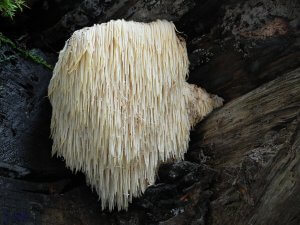Lion’s mane mushroom strictly refers to Hericium erinaceus but other members of the genus Hericium are very similar and can be identified and used in the same ways. This is a genus of edible mushrooms that also have medicinal properties. These mushrooms are easy to identify and have a great unique flavor. Mushrooms in the genus Hericium are sometimes hard to find but they grow in much of north america and the world so it’s beneficial for all of us to be familiar with this unique genus.
Edibility and Culinary Use

Lion’s mane mushrooms grow on mostly living hardwoods, this makes them easy to spot but a little bit hard to prepare sometimes. After you’ve removed the mushroom from the tree it is recommended to cut off all the discolored or woody portions, you should be left with just spongy white material, It often looks a little bit like cauliflower. These mushrooms are extremely absorbent so if you wash them with water you will need to squeeze the water out afterward like you would with a sponge. Their extreme absorbency can be a positive or negative attribute when cooking them. They taste very good fried with butter or oil but do not add a lot of oil since they will soak it up. Here is a simple lion’s mane mushroom recipe. You can also use them is in a soup but keep in mind they will soak up a lot of water and the taste of the soup. The taste is said to be similar to lobster. Historically lion’s mane mushrooms were a delicacy in south east Asia and other parts of the world. It has a long history of culinary use.
Health Benefits
This is another case of a mushroom that should be clinically studied much more to hone in on how effective this mushroom is at treating certain conditions and generally improving health. There is already some information based on scientific data about lions mane mushroom but more would be beneficial. There is a long list of claimed health benefits for lion’s mane mushrooms such as improving brain function, improving nerve generation, helping with Alzheimers, depression, anxiety and much more. There have been some positive clinical studies relating to temporary cognitive improvement for people who are mildly cognitively impaired and improved neuron regeneration.
Cautions

There are no known side effects to Lion’s mane mushroom. These mushrooms are relatively easy to identify but incorrect identification is always a risk for novice mushroom foragers particularly.
Key ID Features
These mushrooms grow on hardwoods. particularly oak and beech. What makes these mushrooms very easy to identify is that they are toothed fungus. The long hanging spines are very unique, mushrooms in the genus Hericium have different length spines, Hericium erinaceus can be identified by spines longer than 1 cm in length.
Conclusion
The lion’s mane mushroom is a great mushroom for beginners because there are no poisonous look a likes if you use proper identification information and it has a very large range where it grows. It’s also a very interesting find for all mushroom hunters because of its interesting look and unique flavor. This mushroom shows very promising results for cognitive and neural improvement as well as a long list of other potential health benefits.
Read our Article on: Safe Foraging
Many of our readers find that subscribing to Eat The Planet is the best way to make sure they don't miss any of our valuable information about wild edibles.
See our privacy policy for more information about ads on this site






